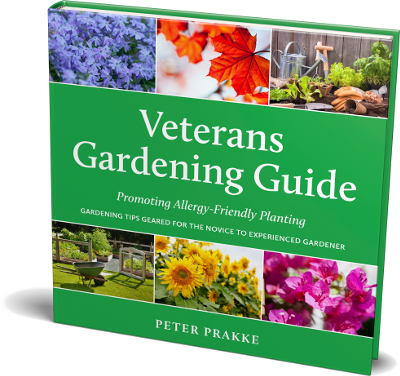
The Veterans Gardening Guide was written to honour our brave and courageous veterans in Canada and the United States. These are the men and women who have served their respective country in times of war and during peacekeeping missions. Veterans deserve the greatest respect and honour for their many contributions.
Being around nature has a calming influence and is conducive to an individual’s overall positive attitude. Everyday stresses seem to dissipate as a person immerses themselves within a natural environment. Parks and gardens foster an appreciation for nature and instill a sense of purpose and responsibility to be a part of maintaining the fragile environmental balance. Research proves that gardening is good for a person’s health. It encourages us to get out in the fresh air and sunshine and to get moving. It is a low-impact exercise that young or older people, those with a disability or suffer from chronic pain can benefit from.
The Veterans Gardening Guide offers a wealth of information for new and experienced gardeners with a focus on allergy-friendly plants. For those with allergies and asthma being around high allergen plants, can cause serious respiratory problems. Using the Ogren Plant Allergy Scale (OPALS®) created by Thomas Ogren, horticulturalist and allergy researcher, the guide lists plant selections along with their OPALS ranking for their potential to cause allergy and asthma reactions. Throughout the Guide, I encourage all gardeners to create a healthy balance with their plant choices.
There are over 21 chapters on relevant gardening topics that include,
- Plants with the potential risk and allergy ranking
- Allergy-Friendly Gardening Q&A
- Attract birds to your garden
- Tree planting for future generations
- Tree pollen cross-reactivity with foods
- Native plants to attract butterflies
- Control insects organically that are taking a bite out of your lawn
- Plants for cleaning the indoor air
- Identify the type of garden soil
- Memorial gardens to create a living tribute to a loved one
- Plant selections for USDA plant zones
- Guide for dividing perennials
- Plant selections for a herb garden
- Drought-tolerant perennials to add to your garden
- Winter protection in your garden
- Honey do calendar with monthly gardening tasks
… Plus a special chapter on Honouring Veterans, including information on how to create a Bravery Park for your town or city.
The Veterans Gardening Guide is a great resource tool for any gardener!
Click on the Contact tab to request further information on the Veterans Gardening Guide NOW available from your favourite online bookseller. Available in eBook and paperback formats! [Please note that online booksellers set their own price and it’s best to compare prices before purchasing. Due to the complexity of the plant information tables and overall book’s design, the eBook is best viewed on a tablet or computer with a viewing screen of 5 inches or larger. You can download your favourite eReader app to your device. EBooks are available online at Kobo or Chapters Indigo or Smashwords. Kindle eReaders are not compatible with the converted ePub file. We thank you for your support!]
– Peter Wynnyczuk, P&A Urban Forestry Consulting Ltd.
 Look Inside!
Look Inside!